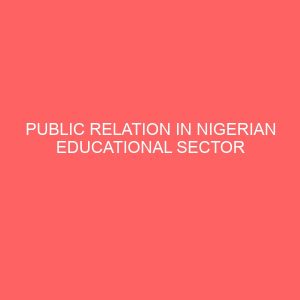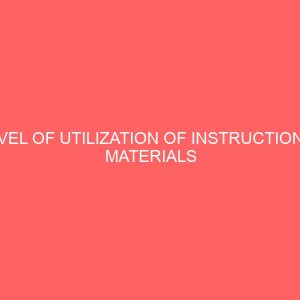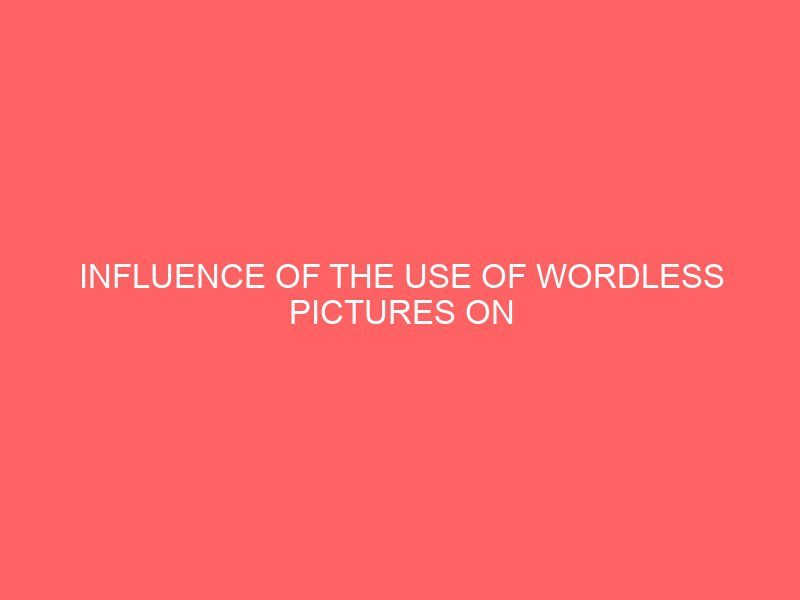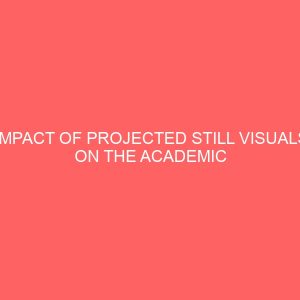Description
CHAPTER ONE
INTRODUCTION
- BACKGROUND OF STUDY
Learning to read and write, on a general note, involves the process of impacting knowledge to a learner or student either through a teacher or another mean s of hearing, the main aim or purpose of learning is to transfer knowledge to a learner and the transfer of these knowledge can be carried out through several processes such as the teaching process and the usual aids provided at the several stages of learning. One of the forms of learning, especially at the upper basic learning level are the usual forms, and an integral aspect of these type of learning process is the use of wordless pictures.
Wordless pictures are described as images without the attachment of words, but with meaning from the expression at the images which is visible by the viewers.
Senior secondary students in schools have gotten used to the different forms of learning available to them, one of such forms of leaning have exposed students to a wider range or ways of reasoning as it expands their imaginative ability and also helps them in remembering what exactly they were thought as pictures have proven to stick in the memories of these children or students than words and this method have proven to be more effective in their educational achievements in reading and writing.
Although such learning dialects starts at the secondary level of education, it started at the pre-primary/ primary stage of learning and has proven to be effective even up to the secondary level where pictures speaks louder than words.
The ability each student has to visualize and understand exactly what he/she sees a huge point to success not only at the secondary level, but if properly nurtured would bring positive interpretational development in their performances as growing students in the areas of reading and writing.
1.2 STATEMENT OF PROBLEM
There is every need to encourage teachers, to adequately use this method of teaching their students, as it has being proven to be effective in broadening how students would visualize and interprete what the wordless pictures they see in books represent, and by so doing their reading and writing skill is improved. As at the moment, most activities of reading and writing are being encouraged by teachers using pictures with write-up’s.
Students on the other hand, fail to take serious the teachers who provide wordless pictures to them, to visualize and draw out meanings to them, ignoring the vast academic benefits to them. Students have to understand, the benefits of having to understand the hidden messages in wordless pictures to improve on how they reason and how they would end up developing their brains to tackle issues in future.
Schools tend not to have adequate resources to encourage the use of this learning method, most schools lack wordless books in their library that can spur imaginations from students, also they tend to be ignorant about such educational materials usefulness. If they encourage the teachers, and the teachers, adopt such method of teaching, students’ academic understanding will improve for the better both in writing as they write about what they see and in reading as they would be able to read and explain to the best of their ability for instance what a wordless picture is all about.
1.3 PURPOSE OF STUDY
Secondary schools in Makurdi, and Benue in general have to find possible ways of including the use of wordless pictures in their curriculum. If this topic is not explored, teachers may not use wordless picture books as a teaching tool to help struggling students develop their reading and writing skills. However, if this topic is explored then students who are reluctant readers and writers, or struggling writers, may find the motivation, and creativity they need to become successful readers and writers. It is apparent that picture books of any kind help children in senior secondary schools develop literacy skills based on several researchers throughout the years. Researchers such as Cassady (1998), Reese (1996) and Hu and Commeyras (2008), have completed studies on ways that wordless picture books have helped with reading and writing for a variety of students. Although picture books can help the literacy rate of a child, it is not always possible for children to have these books accessible to them. Some schools lack the funds to support these books to the classrooms, and some families do not have the ability to purchase a wide array of books for their own children.
The resources that are available to students can impact their development in specific areas, such as writing and reading. When a school budget does not allow for spending on extra materials to help students succeed, the students become victims. Wordless picture books are tools that schools may not feel are necessary to have within the classroom, and therefore teachers do not use them as teaching tools. However, wordless picture books can help children develop skills to begin to read and write effectively.
1.4 RESEARCH QUESTIONS
The following are the research Question that will guide the study:
- What are the main factors that lead to teachers not using wordless pictures, when teaching ?
- What are the main factors that discourage students from understanding the importance of wordless pictures in developing their reading and writing skills ?
- What are the steps to be taken to encourage the use of wordless pictures in schools in makurdi ?
- What are the reading and writing ability of the students taught using wordless pictures like ?
- Are their any significant changes in the student’s academic performance ?
- How should teachers use the wordless pictures, I teaching their students ?
- What are the proper ways to encourage the use of wordless pictures in schools in makurdi ?
1.5 HYPOTHESES
The following hypotheses have been made for the purpose of this research work:
- H1: The aims and objectives of encouraging schools in adopting the use of wordless pictures in teaching students, has being accomplished.
- H2: The aims and objectives in encouraging students in taking learning to read and write seriously with the help of wordless pictures has being understood.
- H3: From all indications, teachers can now appreciate their students, who differently have ideas to how they visualize things and draw individual conclusions
1.6 SIGNIFICANCE OF THE STUDY
The following are the significances of this study on the use of wordless pictures on student’s achievement in reading and writing in senior secondary schools:
- To encourage schools, teachers, and students in using educational materials with wordless pictures.
- To encourage the appropriate governmental agencies saddled with the responsibility of planning educational curriculums to include teaching with wordless pictures for schools.
- To encourage schools to make available wordless pictures in their libraries and classrooms.
- To encourage schools to tests students reasoning abilities by setting tests with wordless pictures.
1.7 SCOPE OF THE STUDY
This study is concentrated on encouraging the adaptation and proper utilization of wordless pictures in improving the reading and writing skills of senior secondary school students in makurdi, Benue state.
Selected schools in makurdi, benue state formed the schools used for this study, as data gotten from students and teachers showed how well wordless pictures were being used in their schools based on the curriculum from Ministry of Education.
1.8 OPERATIONAL DEFINITION OF TERMS
Wordless: This refers to pictures, pictures and video’s that contain no write-ups or accompanying words.
Pictures: This are visual representations of different kinds of pictures, that portray in a deeper sense of understanding, when carefully analyzed.
Writing: Refers to the act of putting down informations on a suitable medium for further referencing.
Reading: This refers to the act of understanding words and being able to pronounce words meaningfully in the words.
Visualize: the ability to see pictures and tell what they represent.
Students: refer to a selected population of a school.









Reviews
There are no reviews yet.